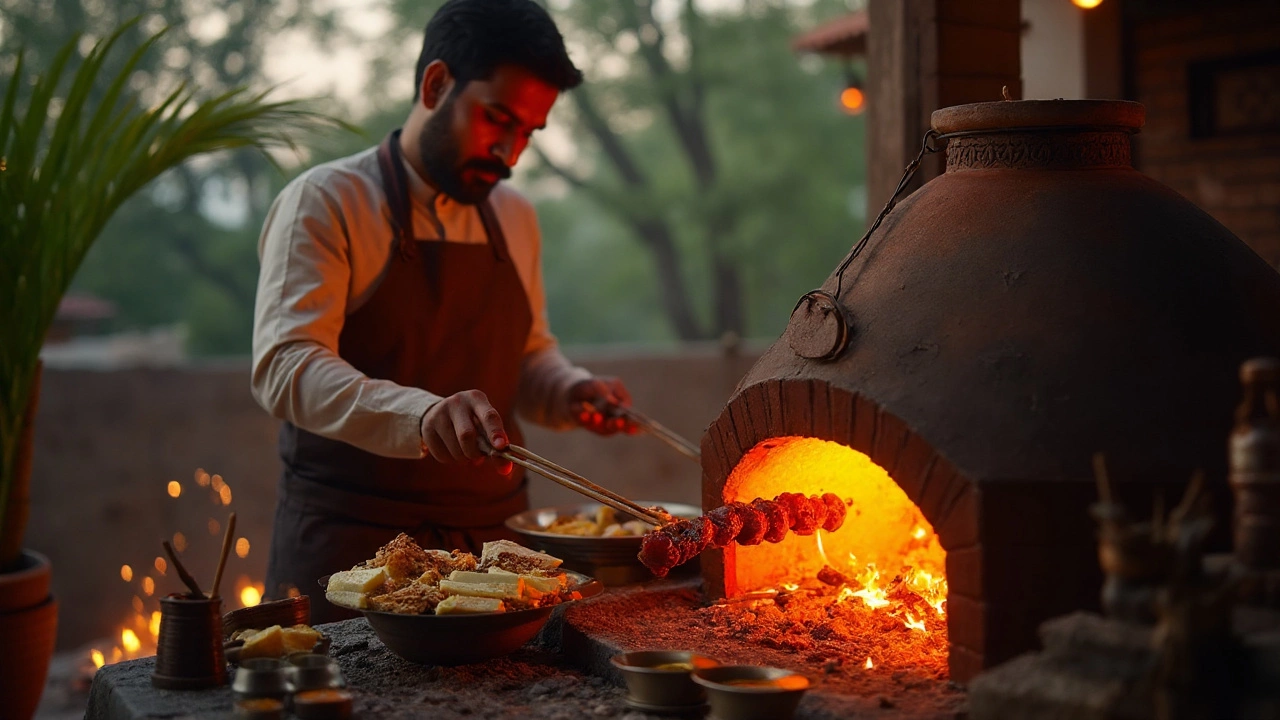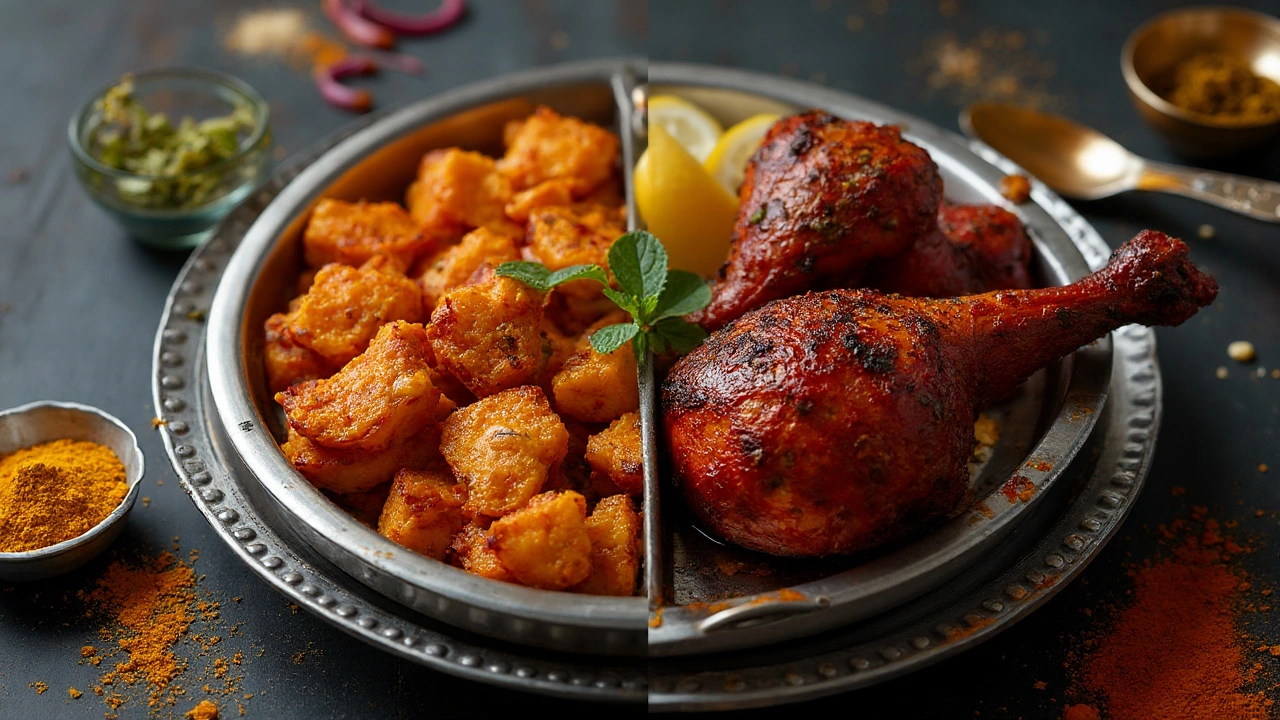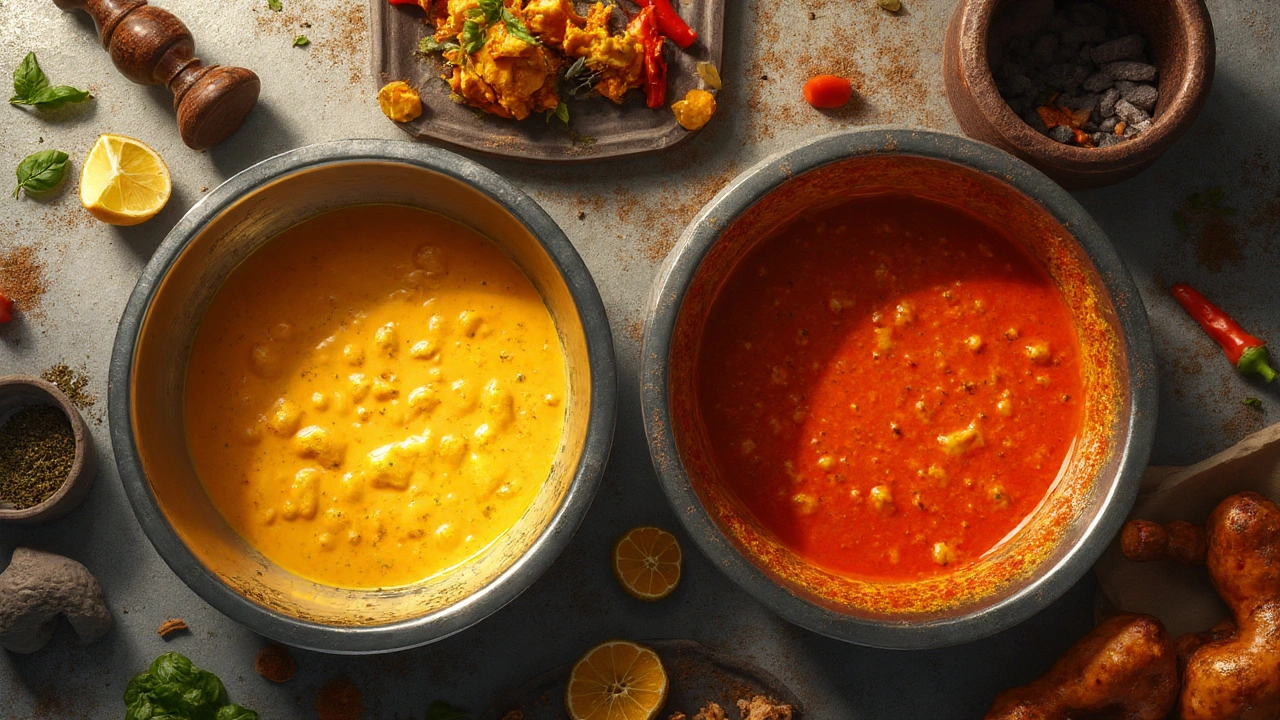You’ve seen both on menus and in spice aisles. One promises that signature brick-red sizzle, the other leans creamy and mellow. The core question is simple: what’s the real difference between tikka and tandoori seasoning, and which one should you reach for at home? Here’s the no-nonsense breakdown, with quick blends, when to use which, and how to get that restaurant-style colour and char without a tandoor.
TL;DR: Tikka vs Tandoori Seasoning
- tikka vs tandoori: Tikka seasoning is a gentler, yogurt-forward blend built for boneless pieces (think chicken or paneer). Tandoori seasoning is punchier, smokier, and designed to stand up to high heat and bone-in cuts.
- Ingredients: Both share cumin, coriander, chilli, and garam masala. Tikka leans creamy (yogurt + kasuri methi), often paprika/Kashmiri chilli for colour. Tandoori adds sharper edges (ajwain/carom, black pepper, mustard oil, sometimes more turmeric).
- Texture & finish: Tikka aims for tender, moist, and lightly charred. Tandoori aims for bolder spice crust and deeper char.
- Use cases: Tikka for boneless, quick-cooking skewers and paneer. Tandoori for drumsticks, whole legs, prawns with big char, or veg that can handle a robust crust.
- Kitchen reality: No tandoor? Use a very hot grill, broiler, or air fryer. Kashmiri chilli = red colour without high heat; avoid artificial red dye.
What Each Seasoning Actually Is (and Isn’t)
First, a quick reset. “Tikka” isn’t just a spice blend; it literally means small chunks or pieces. “Tandoori” is any food cooked in a tandoor, the roaring clay oven. Over time, in UK kitchens and on supermarket shelves, both became shorthand for two distinct flavour profiles. That’s where the confusion starts-and where your cooking gets easier once you separate technique from taste.
Here’s the everyday difference you’ll taste in your kitchen:
- Tikka seasoning: gentler heat, aromatic, often a hint of sweetness from paprika or Kashmiri chilli, rounded with yogurt. It’s the base that later becomes “chicken tikka masala” when you add a sauce, but the tikka itself is a dry, marinated, grilled piece.
- Tandoori seasoning: spikier and bolder. You’ll notice the bite of black pepper and carom (ajwain), sometimes an earthy note from mustard oil, and a brighter hit of turmeric. It’s built to taste alive after a blast of heat.
Store-bought jars often blur lines. Many “tikka masalas” and “tandoori masalas” share 70-80% of the same spices. The difference shows up in ratios and the wet marinade around them. In Birmingham curry houses, tikka marinades almost always have more yogurt and kasuri methi (dried fenugreek leaves), while tandoori mixes use a touch more oil, acid, and spices that stay loud after charring.
Let’s zoom into the spices you’ll see repeatedly, and what they do.
- Cumin and coriander: the backbone. Cumin adds warmth; coriander keeps it citrusy and bright.
- Chilli: Kashmiri chilli for colour with gentle heat; regular chilli powder or cayenne for stronger heat. Smoked paprika adds smokiness without burning.
- Turmeric: earthiness and golden hue. More common in tandoori.
- Garam masala: the fragrant finish (cinnamon, cardamom, cloves, etc.). Often added towards the end of blending.
- Ajwain (carom) and black pepper: the tandoori edge. They sharpen the taste and cut through fat.
- Kasuri methi: the tikka signature. A pinch brings that “restaurant” aroma.
- Acid and fat: Yogurt softens proteins for tikka. Oil (often mustard oil in traditional tandoori) carries flavour and helps browning.
Colour matters. Many older recipes or cheap jarred mixes rely on artificial red dye. Skip it. Kashmiri chilli gives you that bold red without the burn and without staining mouths neon. If you only have regular chilli, blend 2 parts paprika to 1 part chilli to balance colour and heat.

When to Use Each (and How to Cook Without a Tandoor)
Think of tikka as your go-to for juicy, boneless, quick-cooking bites. Think of tandoori when you want dramatic char and a braver spice crust-especially on bone-in chicken or sturdy veg like cauliflower.
Use these quick rules of thumb:
- Protein size: Small, even pieces = tikka. Big or bone-in pieces = tandoori.
- Texture goal: Tender and creamy = tikka. Charred and bold = tandoori.
- Heat tolerance: Mild crowd = tikka. Heat lovers = tandoori (or just add more chilli to either).
- Cook method: Pan or air fryer = tikka is easier. BBQ, grill, broiler = both, but tandoori shines.
Now the practical bit: simple, reliable blends and marinades you can make from a UK pantry. Adjust salt to taste.
DIY Tikka Dry Blend (for 500g protein)
- 1.5 tsp ground cumin
- 1.5 tsp ground coriander
- 2 tsp Kashmiri chilli (or 1 tsp paprika + 1 tsp mild chilli)
- 1 tsp sweet paprika (optional for extra colour)
- 1 tsp garlic powder
- 0.5 tsp ginger powder
- 0.5 tsp garam masala
- 0.5 tsp kasuri methi, crushed between fingers
- 0.5-0.75 tsp fine salt
Wet tikka marinade: Whisk dry blend with 120-150g thick yogurt, 1 tbsp lemon juice, and 1 tbsp neutral oil. For dairy-free, use plain coconut yogurt. Aim for a thick coat that clings but isn’t gloopy.
DIY Tandoori Dry Blend (for 500g protein)
- 1.5 tsp ground cumin
- 1.5 tsp ground coriander
- 1 tsp turmeric
- 1.5-2 tsp Kashmiri chilli (or 1 tsp chilli + 1 tsp smoked paprika)
- 1 tsp black pepper
- 0.5 tsp ajwain (carom), lightly crushed
- 0.75 tsp garlic powder
- 0.5 tsp ginger powder
- 0.5 tsp garam masala
- 0.75-1 tsp fine salt
Wet tandoori marinade: Whisk dry blend with 80-100g yogurt, 1 tbsp lemon juice or vinegar, and 1-2 tbsp oil (mustard oil if you like its aroma; otherwise rapeseed or sunflower). This marinade is slightly thinner than tikka to help baste and char.
Marinating times
- Chicken breast/thigh pieces (tikka): 1-4 hours. Overnight gives the best texture.
- Bone-in chicken (tandoori): 4-12 hours. Slash deep to the bone so flavour travels.
- Paneer: 30 minutes-2 hours. Longer makes it too soft.
- Firm veg (cauliflower florets, potatoes parboiled, peppers, mushrooms): 30-90 minutes.
- Prawns: 20-40 minutes; they over-marinate fast.
Cooking without a tandoor
- Oven + grill (broiler): Preheat oven to 220°C (fan 200°C). Arrange on a wire rack over a tray. Bake 12-18 minutes for tikka pieces, 25-35 minutes for bone-in. Finish 1-3 minutes under a hot grill for char. Flip once.
- BBQ: Bank coals to one side. Start over indirect heat, finish over direct heat for char.
- Air fryer: 200°C, shake or flip halfway. Tikka: 8-12 minutes. Bone-in chicken: 18-25 minutes (size matters).
- Pan: Use a heavy griddle. Lightly oil, sear hard, then lower heat to finish. Don’t overcrowd.
Food safety isn’t guesswork. For chicken, go by temperature: the UK Food Standards Agency uses 75°C as a clear safety point for poultry. A quick-read thermometer takes out the fear and saves you from overcooking.
What about that famous red colour? Use Kashmiri chilli and a touch of paprika. Brushing with butter or ghee right after cooking deepens colour and gloss. If your spice mix contains artificial dye, you’ll see “FD&C” or “E” numbers on the label-skip those when you can.
What shops in the UK carry the right spices? Most big supermarkets in Birmingham stock TRS or East End cumin, coriander, and Kashmiri chilli. Asian grocers carry kasuri methi and ajwain. Don’t stress brand-freshness matters more. If your chilli smells flat, it will taste flat.
How restaurants keep tikka juicy (yes, even when you don’t): they salt early, use thick yogurt, and blast high heat. At home, pat protein dry, marinate long enough, and cook hot and fast. Rest pieces for 3-5 minutes before serving so juices settle.
Cheat-Sheet, Examples, and Real-World Swaps
Here’s a quick way to decide which path to take and how to adapt on the fly.
Decision cheat-sheet
- If it’s boneless and tender (chicken thigh, paneer, tofu): go tikka.
- If it’s bone-in or you want big char (drumsticks, whole legs, cauliflower steak): go tandoori.
- Feeding spice-shy kids? Use tikka, cut chilli by half, add extra kasuri methi.
- Want smoky BBQ vibes? Use the tandoori blend, swap 1 tsp chilli for smoked paprika, cook over charcoal.
Example: Chicken thigh skewers (tikka)
- Cut 600g boneless thighs into 3-4cm chunks. Pat dry.
- Coat with the tikka wet marinade. Rest 3-4 hours.
- Skewer, leaving tiny gaps for heat flow.
- Grill on high heat 10-12 minutes, turning once. Brush with melted butter at the end. Rest 3 minutes. Squeeze lemon.
Result: Juicy, gently spiced, great for wraps or with a chutney.
Example: Tandoori chicken legs
- Slash 4 chicken legs to the bone. Rub with 1 tsp salt + 1 tbsp lemon. Rest 10 minutes.
- Coat with tandoori wet marinade. Rest 6-12 hours.
- Roast at 220°C (fan 200°C) for 25-30 minutes. Grill 2-3 minutes to char. Check 75°C internal at the thickest point.
- Brush with ghee. Rest 5 minutes. Scatter chaat masala if you like a tangy finish.
Result: Deep colour, assertive spice crust, meat pulls from the bone.
Vegetarian options
- Paneer tikka: Press-paneer dry, marinate lightly, cook hot and fast. Over-marinating makes it crumbly.
- Tandoori cauliflower: Parboil florets 2 minutes, drain, then tandoori marinade. Roast hot until edges char.
- Tikka tofu: Extra-firm tofu, pressed 30 minutes, then a short tikka marinade. Air fry for crisp edges.
Common swaps
- No kasuri methi? Crumble a tiny pinch of celery leaves with a whisper of maple syrup. Not the same, but it mimics herbal-sweet notes.
- No ajwain? Use a very small pinch of thyme + extra black pepper for that sharp edge.
- No Kashmiri chilli? 2 parts paprika to 1 part chilli powder gets you close on colour and heat.
- No mustard oil? Use rapeseed oil and a pinch of ground mustard or a dot of English mustard for aroma.
Avoid these pitfalls
- Too much yogurt for tandoori: it slides off and blocks char. Keep it thinner than tikka.
- Skipping salt in the marinade: salt early so seasoning moves inside, not just on the surface.
- Cold meat on a hot grill: leads to burnt outside, raw centre. Take it out 20 minutes before cooking.
- Overcrowding: steam kills crust. Leave space between pieces.
- Using only chilli for colour: you’ll chase heat and still miss the red. Use Kashmiri chilli or paprika blend.
If you only want one jar in the cupboard: buy a good-quality “tandoori masala” and tame it with yogurt and kasuri methi for tikka nights. It’s easier to soften a bold blend than to crank up a mild one.
Taste like a pro
- Toast whole spices (cumin, coriander) lightly and grind fresh; 60 seconds in a dry pan brings them to life.
- Add garam masala at the end of mixing-its volatile aromas fade with too much heat.
- Sweetness balance: a 1/2 tsp honey or jaggery in tandoori can round sharp edges without tasting sweet.

Mini‑FAQ, Quick Checks, and Troubleshooting
Are tikka and tandoori the same seasoning? No. They overlap but aim for different outcomes. Tikka skews creamy-aromatic; tandoori is bolder and built for heavy char.
Can I use tikka spice on bone-in chicken? Yes, but add more salt, a touch more chilli, and reduce yogurt so it doesn’t slip off. Or start with tandoori and add kasuri methi for a hybrid.
Why is restaurant tandoori so red? Often Kashmiri chilli plus paprika; sometimes artificial colour. You can get 90% of that look with Kashmiri chilli, paprika, and a butter baste at the end.
Must I use mustard oil? No. It’s traditional in some regions for its punchy aroma, but rapeseed or sunflower oil works. Add a tiny pinch of mustard powder if you miss the note.
What’s the difference between tikka seasoning and tikka masala sauce? Tikka seasoning is a dry or wet marinade for grilling. Tikka masala sauce is a separate curry base (tomato-onion, cream or yogurt) you add after grilling the tikka pieces.
My tikka is pale and tastes flat-why? Usually low heat, weak chilli, or old spices. Use Kashmiri chilli for colour, fresh spices, and finish under a hot grill. A squeeze of lemon lifts the finish.
My tandoori crust won’t char-what am I doing wrong? The marinade is likely too wet or the tray is overcrowded. Reduce yogurt, increase oil slightly, and cook on a rack with space. Hit it under the grill for 1-3 minutes at the end.
Can I make it dairy-free? Yes. Use a thick coconut yogurt for tikka and a thinner, oil-forward marinade for tandoori. Add 1 tsp gram flour (besan) to help it cling.
Health and safety check (because dry chicken is sad, but unsafe chicken is worse): aim for 75°C internal for poultry. Let cooked pieces rest a few minutes; they stay juicy without bleeding onto the plate.
Troubleshooting by symptom
- Too sour: Next time reduce lemon/vinegar by 1/2 tbsp and add a pinch of sugar or more yogurt.
- Too spicy: Add yogurt or cream when serving, or brush with butter/ghee to soften heat.
- Bland centre: Salt earlier, marinate longer, and cut deeper slashes for bone-in pieces.
- Dry texture: Overcooked. Cook hotter and shorter; use a thermometer. For tikka, add 1 tbsp oil to the marinade.
- No aroma: Your garam masala is old. Buy smaller packs and store in a tight jar away from light.
Next steps: Try a side-by-side test in one meal. Do half your chicken as tikka, half as tandoori, using the blends above. Same oven, same tray, finish under the grill. Taste the difference in spice edge, char, and juiciness. Once you feel it, picking the right seasoning becomes second nature.
You don’t need a tandoor in the garden or a restaurant stash of secret powders. With fresh spices, heat you can trust, and a clear goal-creamy-aromatic tikka or bold-charred tandoori-you’ll get that proper North Indian grill flavour right at home.
